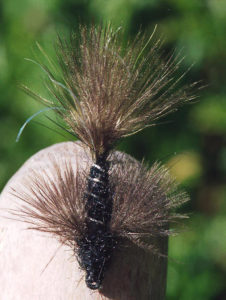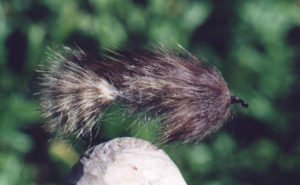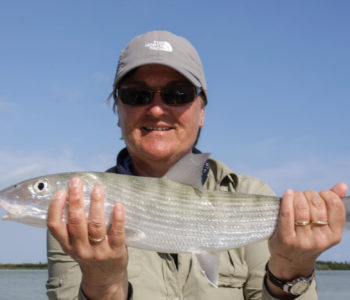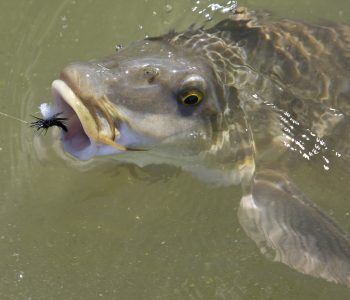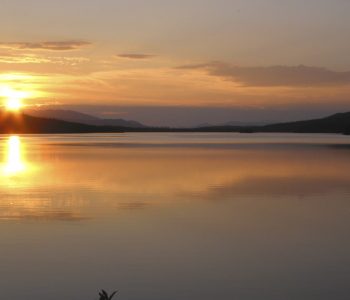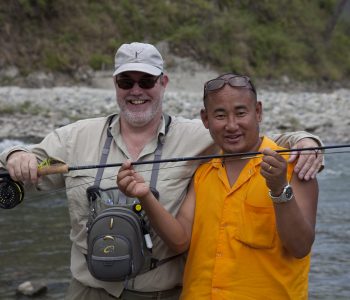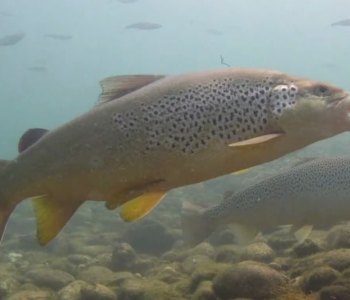
Norwegian Power Story
The three most recent additions to the group of patterns that I designed in Norway are already a few years old. As usual, they were developed on the banks of the mighty Glomma River, but this time under very difficult local conditions. My trip coincided with the aftermath of a massive flood, and while I had the best wild trout fishing of my life, my joy was tempered by the sorrow of local people who had lost a great deal to the raging waters.
Fishing during “The flood of the century”
On our way to the river we passed many flooded areas and the road beside the Glomma had just been reopened. The lower part of the river was unrecognizable and in some places the water has risen over fifteen feet. Some farmhouses were completely flooded or had been carried away by the unbelievable power of the current. The damage was much less in the upper part of the river, but the water level was still seven feet above normal. Arriving at our cottage, I realized that the fishing would be very difficult. These were the highest water levels I had experienced in eastern Norway and river fishing seemed almost impossible. The banks were completely flooded, the water coloured, and all my hot spots unreachable. Wading was very dangerous so the only thing I could do was to try some quiet places close to the riverbank. To search for fish and gauge the depth of the holes in the flooded areas, I tried my Leadhead nymph. I caught one small fish, but most of the time the heavy bug got stuck in the flooded grasses. I was certain the fish were there, but by the end of the afternoon I had landed only three small trout and lost many of my weighted bugs.
The Toddler
After a frustrating day, I tied a few extra of my Lost Caddis pattern (an unweighted nymph) in the evening, intending to try them the following day. Maybe I could avoid the problem of hooking the unseen grasses and debris. This pattern has a collared partridge hackle at the rear, immediately forward of the tag. As an experiment, I omitted the collar and just added a few fibres on each side of the tag to see if it made any changes in the pattern’s mobility. Then, while working the dubbing forward, I was inspired to tie in the longer, leftover fibres of the partridge hackle at the midpoint of the body. I tied them on each side of the hook shank, like a little delta wing, and finished the fly with dubbing. The result looked very fishable.
Next morning, the new pattern was an instant hit, and some larger fish came to hand. The idea to use an unweighted pattern in this situation was the key. I lost only one fly and landed thirteen fish. After lunch I experimented with different fishing techniques and lost a very nice trout. In the evening I tried a canal that had proven to be an extremely good spot during high water conditions. The water was much clearer, but the dry fly was still useless, with nary a rise all evening. Just before leaving, I made a last attempt with the Toddler and missed a very good fish. Encouraged, I put on my waders and walked upstream over the flooded banks. Carefully, I might add, as one wrong step and the river would take me for a nasty ride. I cast down-and- across, mended the line, and worked the Toddler upstream with little movements. When the fly got close to the normal bank position, a huge swirl appeared. It happened several times but the fish was not aggressive enough to take the little fly. Back at the cabin, I evaluated the situation further and decided to try bigger flies and a sinktip line the next evening.
The Frumpy Seducer
The Toddler had done well, at least for the places I was able to fish, but I still wanted a bigger pattern and, if possible, with more mobility. So, the next morning, I searched through my tying stuff and spotted a Hoffman cape with some Chickabou included. I took a much bigger hook, deleted the tag, and instead used a few fine Chickabou tips for the tail. Squirrel dubbing replaced the hare to give the body a rougher and livelier appearance. Next, I used the Chickabou deliberately as pectoral fins to ensure the greatest mobility, and placed them a little further towards the head of the fly. Like the Toddler, I finished the fly with a bulkier head of dubbing. When I tried the fly in front of our cabin, the action and mobility of the pattern amazed me. Outside the water the fly looked terrible, really frumpy, which inspired the pattern’s name. In the evening I went back to the canals and had my best-ever-wild trout fishing in Norway. A combination of the unweighted pattern and a twenty-four foot sink-tip seemed to be the magic touch.
Actually, it was the only way to present the fly under the banks where the fish were lying. Normally, two or three large fish is a good evening, but that evening I released eight beauties between fifty-eight and sixty-two centimeter’s; all within four hours. Certainly, the long period of high water had concentrated the trout, but the Frumpy proved superb for exploiting the situation. And, I’m sure the lack of fishing pressure—everyone else was completely put off by the conditions—helped as well. However, there was more to come.
Norwegian Power
I used the Frumpy for almost a week and the results were amazing. Not only in the Glomma, but also in the local tributaries and lakes. The largest trout was just one centimeter under my personal record, caught fourteen years earlier. At the start of our last week we had a very cold and rainy day, so I stayed in the cabin and played with thread and feather. I made several Frumpies and tied a few salmon flies for our next destination. Perhaps, I thought, I could make a larger Frumpy including the action of the Bondals and Pulsars (two of my salmon patterns). After a couple of hours of experimenting, the final result appeared. It was a mixture of the Frumpy, Pulsar, Bondal, and Zonker. A fly completely designed with Norwegian backgrounds, and so named the Norwegian Power.
The reward for my efforts was enormous. I first tried the Norwegian Power on the evening the locals celebrate their midsummer night. When I drove to one of my favourite fishing places, I enjoyed the big campfires beside the riverbank. It is the locals’ way to celebrate the longest day of the year. It was a wonderful evening and it became even better.
When I reached my hot spot, the high water had just receded beyond the banks. There were no footprints, a very good sign. The mud made walking difficult. Dry-fly fishing was still useless, so I tried several of my nymphs, like the Caseless Caddis and Remerger. I got one grayling and a beautiful whitefish, but was a little disappointed because this is absolutely the best fishing mile in Norway that I know of—time to experiment. I landed a nice trout on the Frumpy but then the water seemed to go dead. In desperation, I tried the Norwegian Power in combination with a 7-weight rod and twenty-four foot sink-tip. To use this heavier equipment I went to a huge pool where a small tributary runs straight into the Glomma River at a right angle. In this area the Glomma has many big pools and they all are known for large fish. Unfortunately such places are extremely hard to fish with wet flies. Most of pools are very deep and have many currents that flow in contrary directions to the main stream. A sink-tip line is a good tool and had succeeded in the past.
I made about seven casts and fished the Norwegian Power with as much action as I was able to give it—nothing. Then, after cast number eight, I waited a littler longer than I wanted to retrieve the fly.
Stuck on bottom, at least that’s what I thought. When I pulled on my line I realized that it must be big stick because I hardly could move it and I can assure you that I gave a lot of pressure. When the stick started to move by itself I was sure it was a huge pike or “lota lota” (I don’t know the English name). The fish moved slowly for at least five minutes and ran through the entire pool. Finally, I got the fish out of the current but I still couldn’t play it. It was the same feeling as hooking a large codfish on 5-weight rod. I decided to release tension and just give it some extra line. This wasn’t a success either. It moved to the same spot where it had been hooked originally. I didn’t see the fish at all and that made me very curious. I didn’t know what to do. I beat against my rod, pulled left and right, but nothing happened. So, I stoned the pool. That did it, the fish made a long run and went straight into the mainstream. It took at least forty meters of backing from my reel before turning and moving in the opposite direction. Surely this wasn’t a pike, but what was it? I played it for at least another 10 minutes and began to get a little nervous. I didn’t want to lose that fish.
About 200 meters downstream from the big pool I led it into some quiet water but the landing was still five minutes away. It was a big, beautiful, wild brown trout, and the fly was just holding. As I held it, out came two whitefish and a little trout, the latter still alive. After fourteen years, I had exceeded my personal best, the trout was sixty-eight centimeter’s long. In the following days I caught several of these monsters, all with the same fly and technique. The pattern has worked well in lakes and the saltwater too.
Canadian experience
In Atlantic Canada I only tried the Frumpy and Norwegian Power. Both flies did extremely well for smallmouth bass and brook trout. Remarkable was a caught of four Atlantic salmon with an unweighted version of the Frumpy in Newfoundland. The Frumpy was the best fly by far for brook trout in several of the feeders in the Portland Creek area. A slim tied variation of the Norwegian Power worked well for Atlantic salmon in high water conditions.
Fishing techniques
Depending on the size of the river, I prefer to start with a floating line. If unsuccessful, I usually try a twenty-four foot sink-tip line to present the fly a little deeper. In rivers I mostly cast down and across and retrieve the fly at different speeds. I use the tip of the rod to produce the action. When I use a sinktip I always fish with unweighted versions. For some waters I made an underbody of high floating material to give the fly an extra action. The fly wants to go up but the sink-tip pulls it down while retrieving. This works extremely well in still and saltwater too. With a floating line I do the opposite by using weight in the patterns.

